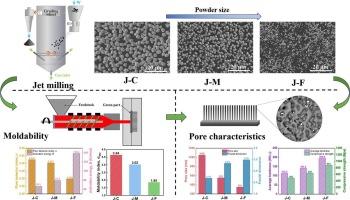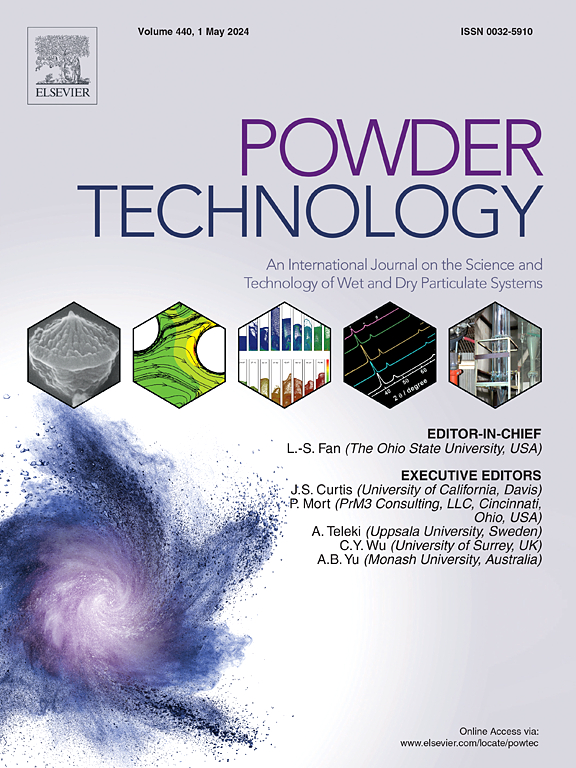粉末粒度对注塑成型多孔钨的成型性和孔隙特征的影响
IF 4.5
2区 工程技术
Q2 ENGINEERING, CHEMICAL
引用次数: 0
摘要
元件形状和孔隙结构对多孔钨的应用至关重要,并且受粉末粒度的影响很大。本研究采用喷射研磨和注射成型相结合的方法制备了具有复杂形状和可控孔隙结构的多孔钨,并系统研究了粉末粒度(5、2 和 0.6 μm)对喷射研磨、注射成型和孔隙结构的影响。结果表明,与微米级粉末的完全分散不同,超细粉末在喷射研磨后仍有残余团聚,这进一步导致了注射成型过程中相对较低的临界固体负荷(47%)和成型性指数(αstv=1.85)。就多孔结构而言,更细的粉末更有利于获得更小的孔径和更复杂的孔隙结构。在相同的孔隙率(27%)下,随着粉末粒度的减小,孔径从 1028 nm 减小到 552 nm 和 350 nm,相应的分形维数从 2.19 增加到 2.84 和 2.99。相反,抗压强度随着粉末粒度的减小而增加,从 488 兆帕增加到 640 兆帕和 883 兆帕。粉末粒度、成型性和孔隙特征之间关系的建立为原材料粉末的选择和孔隙结构的控制提供了有价值的见解,对多孔钨的精确制备和应用推广具有重要意义。本文章由计算机程序翻译,如有差异,请以英文原文为准。

Effect of powder size on the moldability and pore characteristics of porous tungsten by injection molding
Component shape and pore structure are crucial to the application of porous tungsten, and are significantly affected by the powder size. In this work, porous tungsten with complex shape and controllable pore structure were prepared by the combination of jet milling and injection molding, and the effects of powder size (5, 2 and 0.6 μm) on jet milling, injection molding and pore structure were systematically investigated. The results showed that in contrast to the complete dispersion observed with micron-sized powders, ultrafine powder still had residual agglomerations after jet milling, which further led to a relatively low critical solid loading (47 %) and moldability index (=1.85) during injection molding. For porous pore structure, finer powder was more conducive to obtain smaller pore size and more complex pore structure. At the same porosity (27 %), with the decrease of powder size, the pore size decreased from 1028 nm to 552 nm and 350 nm, and the corresponding fractal dimension increased from 2.19 to 2.84 and 2.99. In contrast, the compressive strength increased as the powder size decreased, rising from 488 MPa to 640 MPa and 883 MPa. The establishment of the relationship between powder size, moldability, and pore characteristics provides valuable insights for the raw powder selection and pore structure control, which is of great significance for the precise preparation and application promotion of porous tungsten.
求助全文
通过发布文献求助,成功后即可免费获取论文全文。
去求助
来源期刊

Powder Technology
工程技术-工程:化工
CiteScore
9.90
自引率
15.40%
发文量
1047
审稿时长
46 days
期刊介绍:
Powder Technology is an International Journal on the Science and Technology of Wet and Dry Particulate Systems. Powder Technology publishes papers on all aspects of the formation of particles and their characterisation and on the study of systems containing particulate solids. No limitation is imposed on the size of the particles, which may range from nanometre scale, as in pigments or aerosols, to that of mined or quarried materials. The following list of topics is not intended to be comprehensive, but rather to indicate typical subjects which fall within the scope of the journal's interests:
Formation and synthesis of particles by precipitation and other methods.
Modification of particles by agglomeration, coating, comminution and attrition.
Characterisation of the size, shape, surface area, pore structure and strength of particles and agglomerates (including the origins and effects of inter particle forces).
Packing, failure, flow and permeability of assemblies of particles.
Particle-particle interactions and suspension rheology.
Handling and processing operations such as slurry flow, fluidization, pneumatic conveying.
Interactions between particles and their environment, including delivery of particulate products to the body.
Applications of particle technology in production of pharmaceuticals, chemicals, foods, pigments, structural, and functional materials and in environmental and energy related matters.
For materials-oriented contributions we are looking for articles revealing the effect of particle/powder characteristics (size, morphology and composition, in that order) on material performance or functionality and, ideally, comparison to any industrial standard.
 求助内容:
求助内容: 应助结果提醒方式:
应助结果提醒方式:


